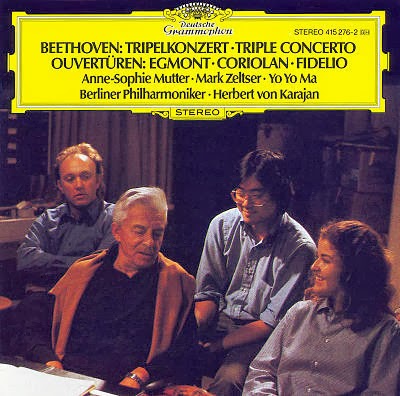
The triple concerto is dedicated to Prince Franz Joseph Maximilian von Lobkowitz. The triple concerto would seem to have been composed between April-September 1804. It received its first known performance in May 1808, and was published in 1807 in Vienna, yet it had already been anticipated in 1802 by fairly substantial sketches for a work in D, calling for the same team of soloists.
But the 40-minute-long Concerto for violin, cello, and piano in C major, Op. 56, known as the Triple Concerto, was the first major piece Beethoven wrote after he and Archduke Rudolph began working together. Cast in three movements with huge parts for the two string soloists and a musically crucial one for the pianist, it premiered in 1808, and there is no record of Rudolf ever having played it. When it came to be published, the concerto bore a dedication to another patron, Franz Joseph Max, or the Prince von Lobkowitz.- allthingsstrings
It may have been intended for a concert in spring of that year. However, the director of the theatre cancelled the concert, leaving Beethoven to turn his attention to the opera.
After a difficult boyhood in Bonn, Beethoven had chosen to settle in his adoptive Vienna, and in the space of five or six years (making much allowance for the gestation and lengthy reworking of his ideas) produced a quantity of masterpieces astonishing by any standards, including the third symphony, the Waldstein and Appassionata sonatas, Fidelio, the Fourth Piano Concerto, the three Razumowsky Quartets and the Violin Concerto.
At this time he was coming to terms with increasingly "meaty" sonata-form structures. The Waldstein and the triple concerto display the lengthiest first movements he had undertaken by that time, and several ideas in the concerto may have been distilled from the piano sonata.
Beethoven's Triple Concerto for violin, cello and piano was written in 1804, after his deafness had plunged him into the depths of depression and at a time when he had begun to rediscover both his confidence and his desire to express himself. It is a work which will tug at your emotions on many levels. A gentler piece of music than the symphonies, it has no less depth and power. The balance and contrast of the three solo instruments demands concentrated listening.
The three soloists - Anne-Sophie Mutter, Mark Zeltser, and Yo Yo Ma -
play with passion, authority, and balance.
There are joyful, as well as bleak, qualities to the Triple, qualities which orchestra and soloists bring to the fore. From the first note you are riveted. It is the sense of authority, the sense of confidence in the blend between soloists and orchestra which is most striking. This is an invigorating recording, one which commands your ear and invites you to listen and feel the emotion.
Ludwig van Beethoven (1770 - 1827)
Concerto for Piano, Violin, and Cello in C, Op.56
1) 1. Allegro [17:48]
2) 2. Largo - attacca [5:50]
3) 3. Rondo alla Polacca [12:32]
http://grooveshark.com/profile/Anne+Sophie+Mutter+Mark+Zeltser+Yo+Yo+Ma+Herbert+Von+Karajan+Berlin+Philharmonic+Orchestra/23163960
Anne-Sophie Mutter - Violin
Mark Zeltser - Piano
Yo-Yo Ma - Cello
Berliner Philharmoniker
Herbert von Karajan
Audio CD (October 25, 1990)
Label: Deutsche Grammophon
David Oistrakh, Mstislav Rostropovich and
Sviatoslav Richter join the Berlin Philharmonic Orchestra conducted by Herbert
von Karajan for a truly legendary recording event!
The label waited many years to get these legendary artists together for this recording and the result was one of the greatest recordings this work has ever received.
The label waited many years to get these legendary artists together for this recording and the result was one of the greatest recordings this work has ever received.
“The warm, expansive music-making confirms even more clearly than before that the old view of this as one of Beethoven's weaker works is quite wrong. The three Soviet soloists revel in the multiplicity of ideas, with Richter in the spare piano part providing a tautening influence.” Penguin Guide, 2011 edition
With three soloists of this high caliber sharing the stage in one concert is quite something, but to have them playing on the same work is fairly unheard of. Couple them with Herbert Von Karajan and what have you got - a flawlessly intuitive recording, especially on the heart-rending second movement.
There is a marvelous dialogue taking place in this concerto between the three main players, David Oistrakh on violin, Mstislav Rostropovich on cello, Sviatoslov Richter on piano, and the Berlin Philharmonic Orchestra masterfully conducted by Herbert von Karajan. These were the great classical maestros of days gone by.
Conductor, Herbert von Karajan
Violinist, David
Oistrakh
Cellist, Mstislav
Rostropovich
Pianist, Sviatoslav
Richter
The Berlin Philharmonic Orchestra
*original post May 2, 2011


Great selection, most possible the best recording of this master piece, I just inhaled it at the weekend (fortunately non of my neighbours complained).
ReplyDeleteThank you...
ReplyDeleteThis is particularly
one modern presentation,
great expressive richness,
excellent sound,
very exciting and vibrant,
with the awesome
Berlin Philharmonic.
Although I much
prefer the CLASSIC 1969
recording of Karajan
with the three great
Russian soloists
(Richter, Oistrakh, Rostropovich),
this one is just as good.
You did? :-)
I did, too,
many times over.
Good neighbors you have!
They must have been
equally well aware of the
incredibly vibrant and
invigorating music
of Beethoven....